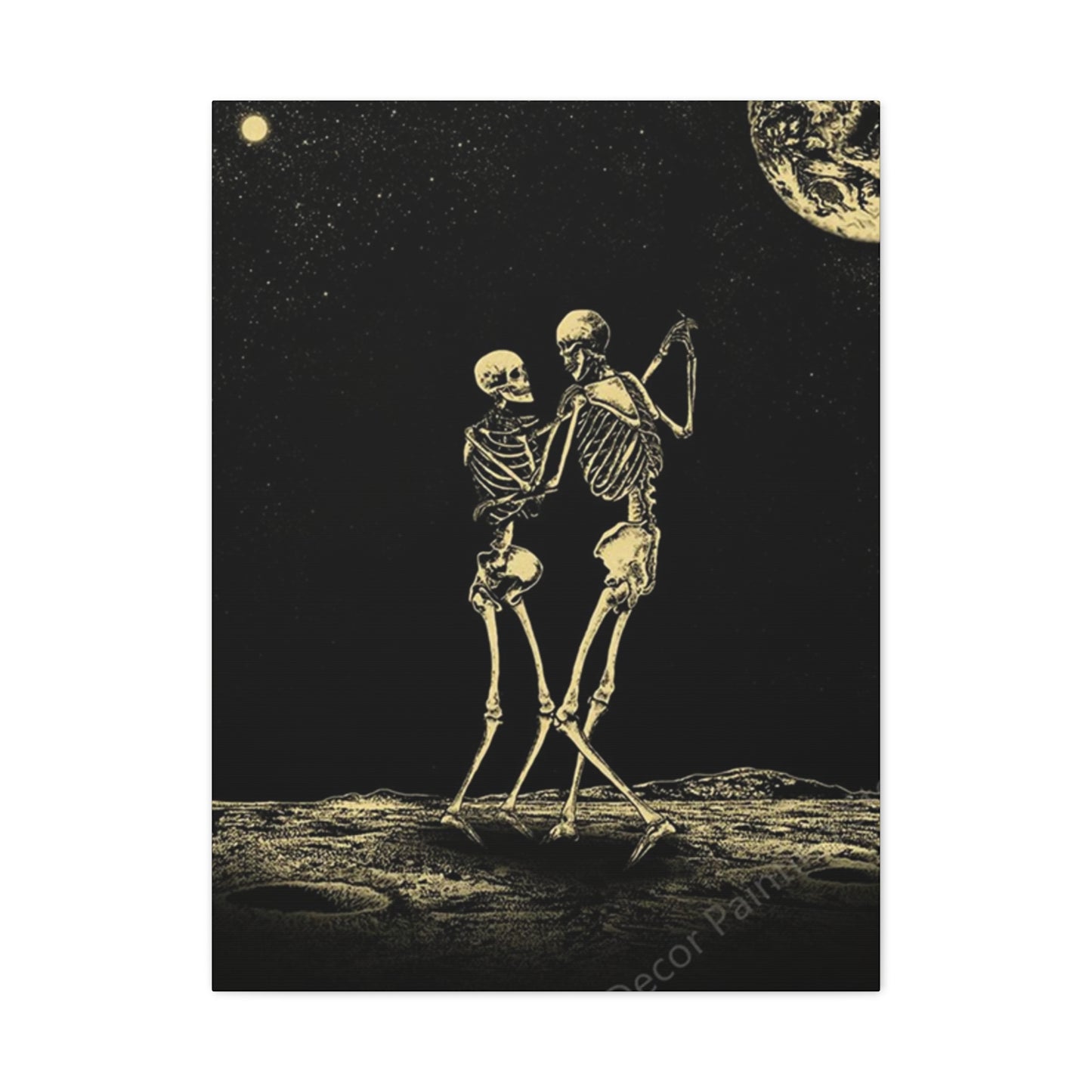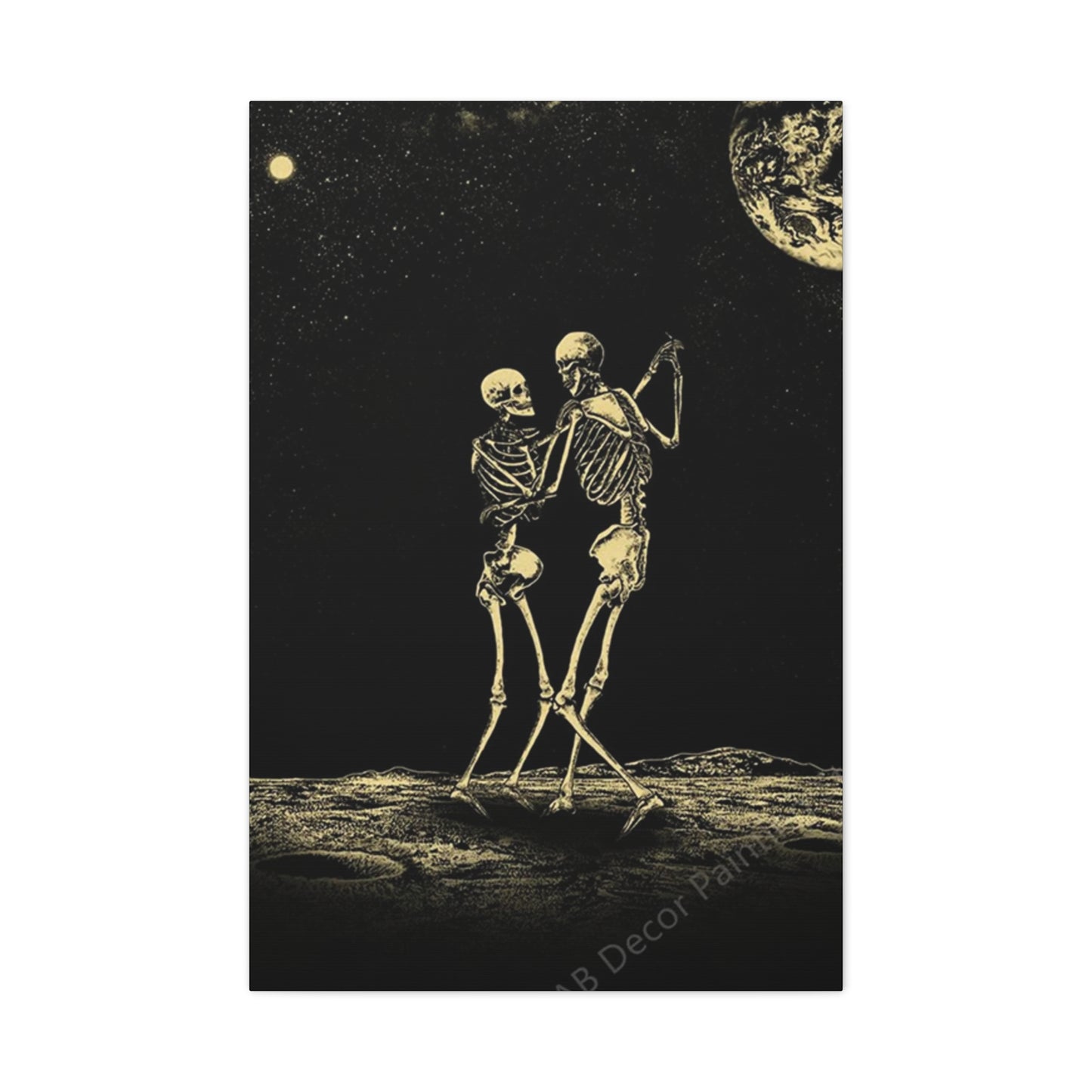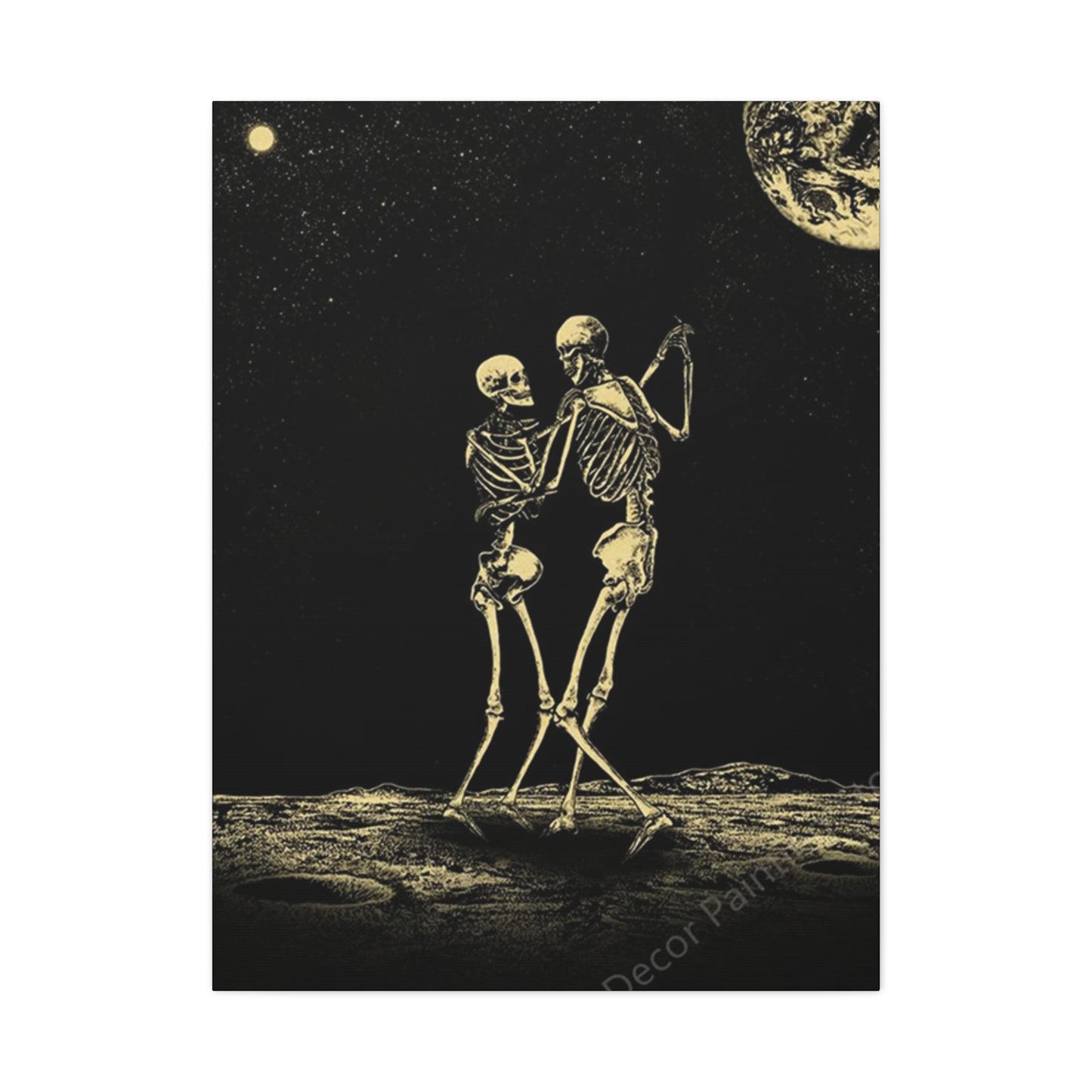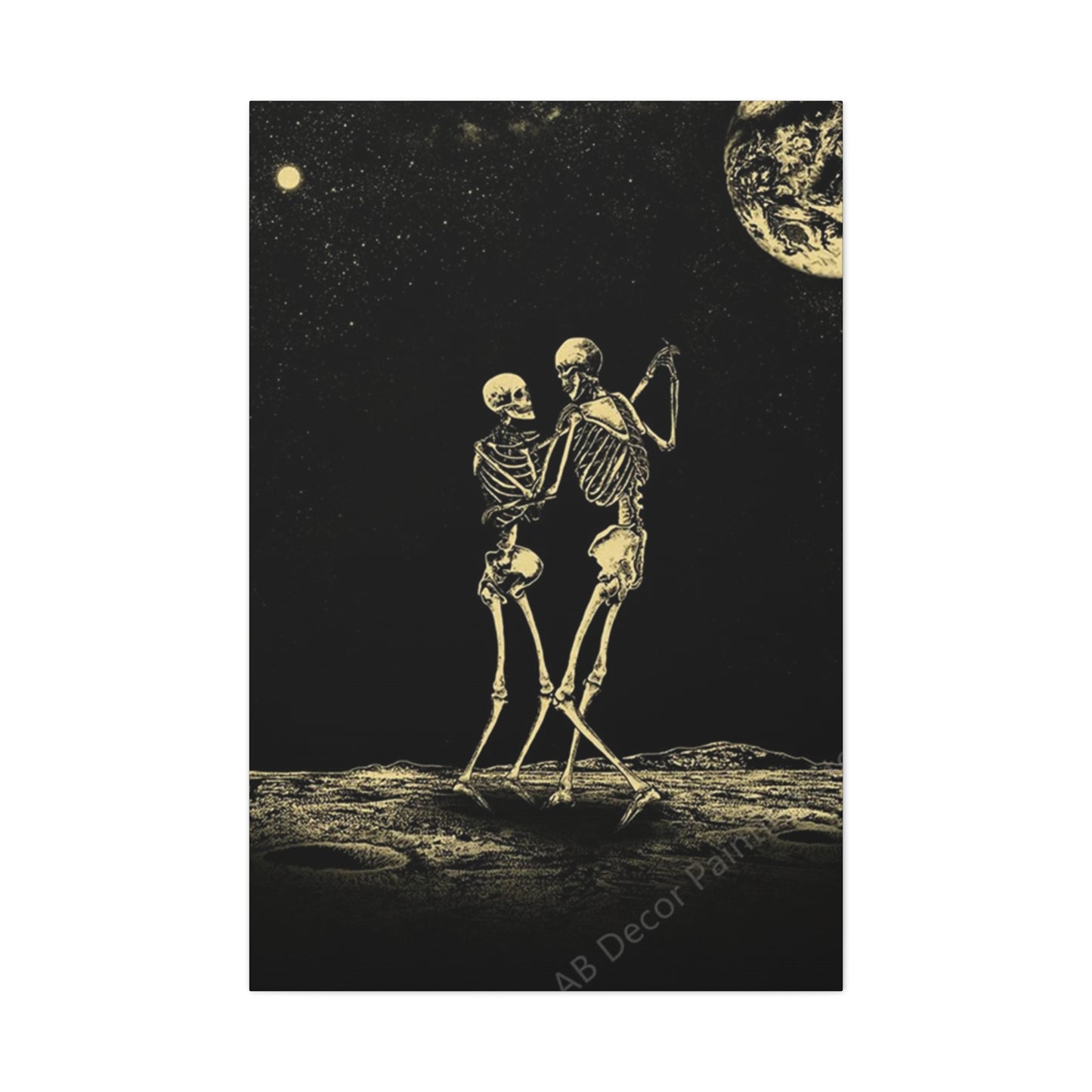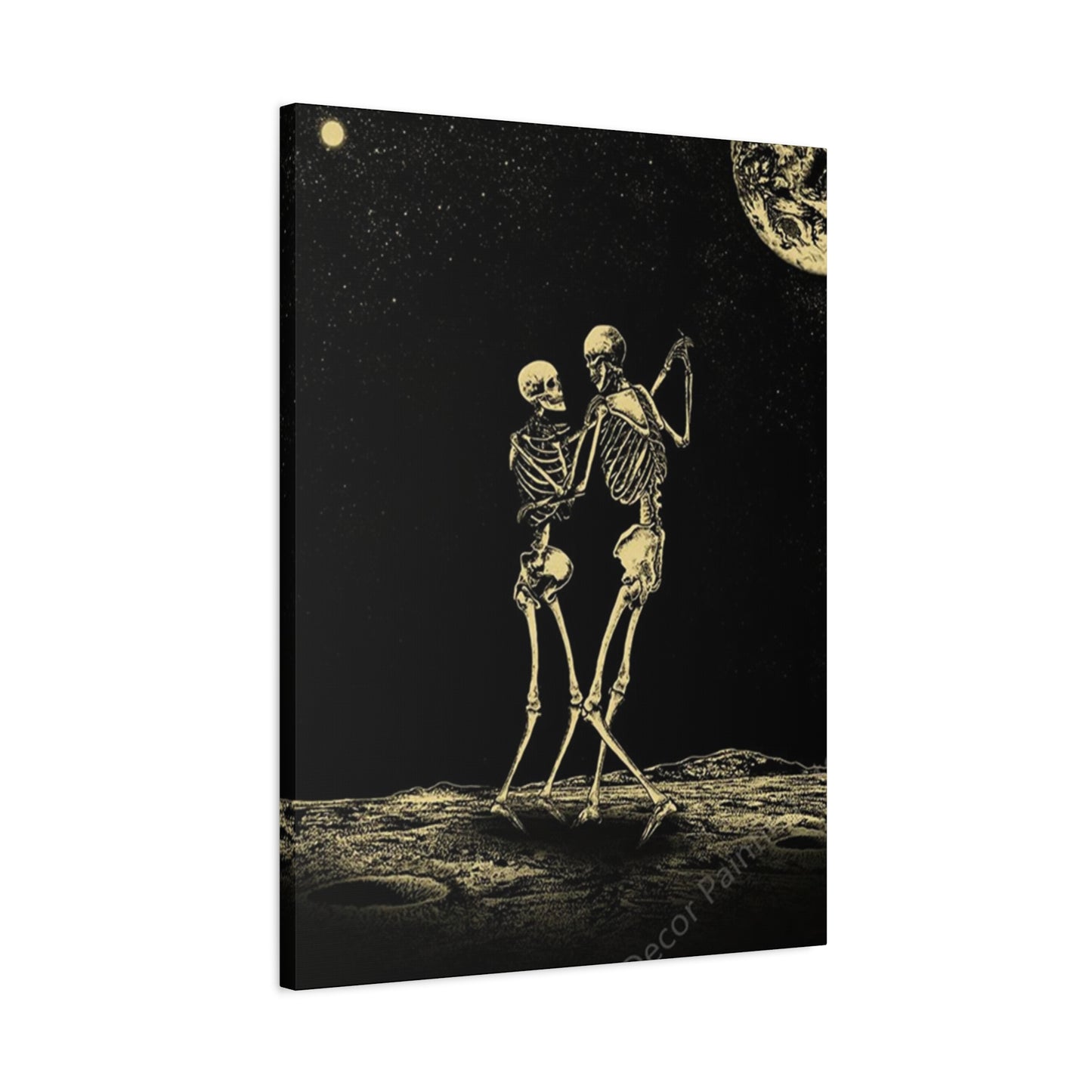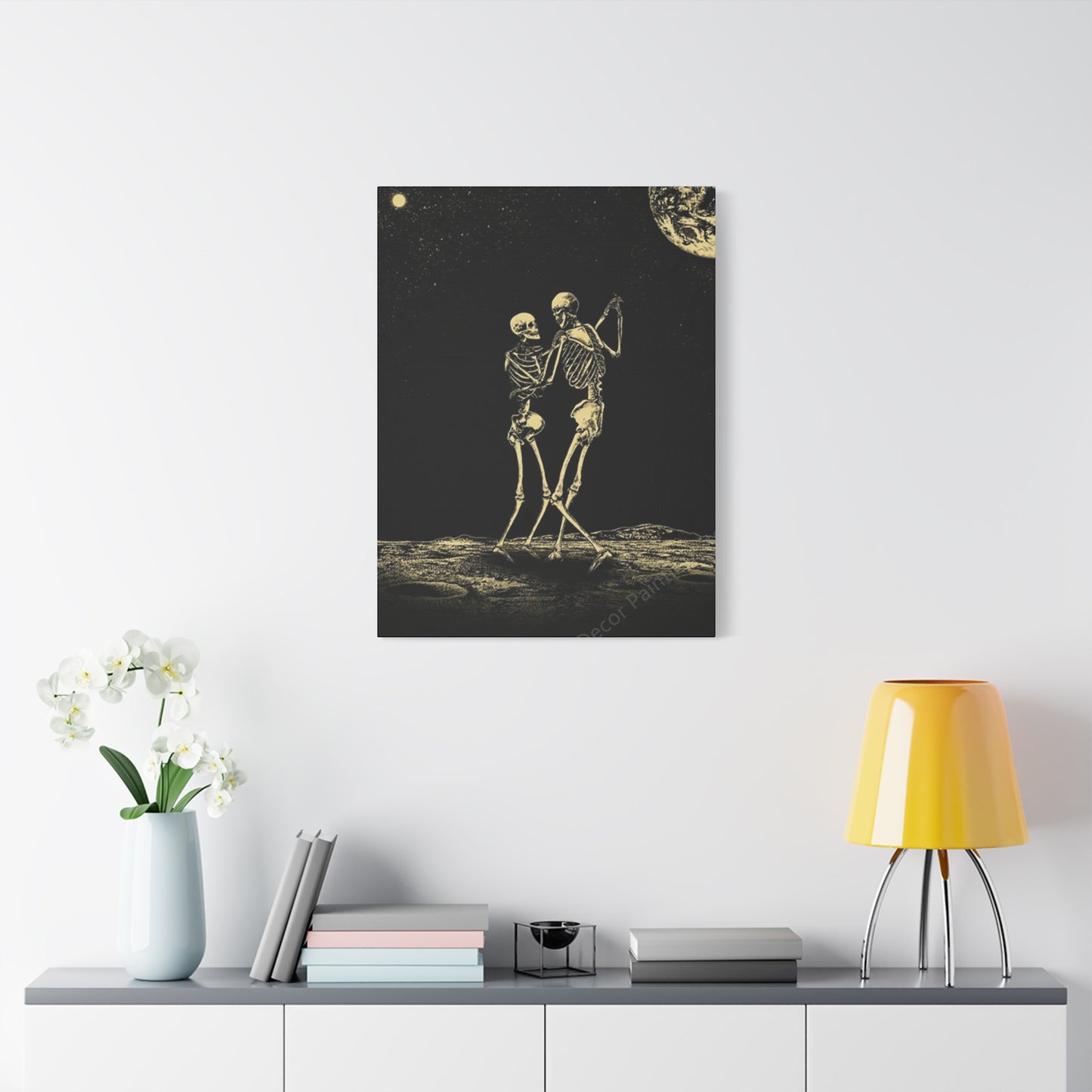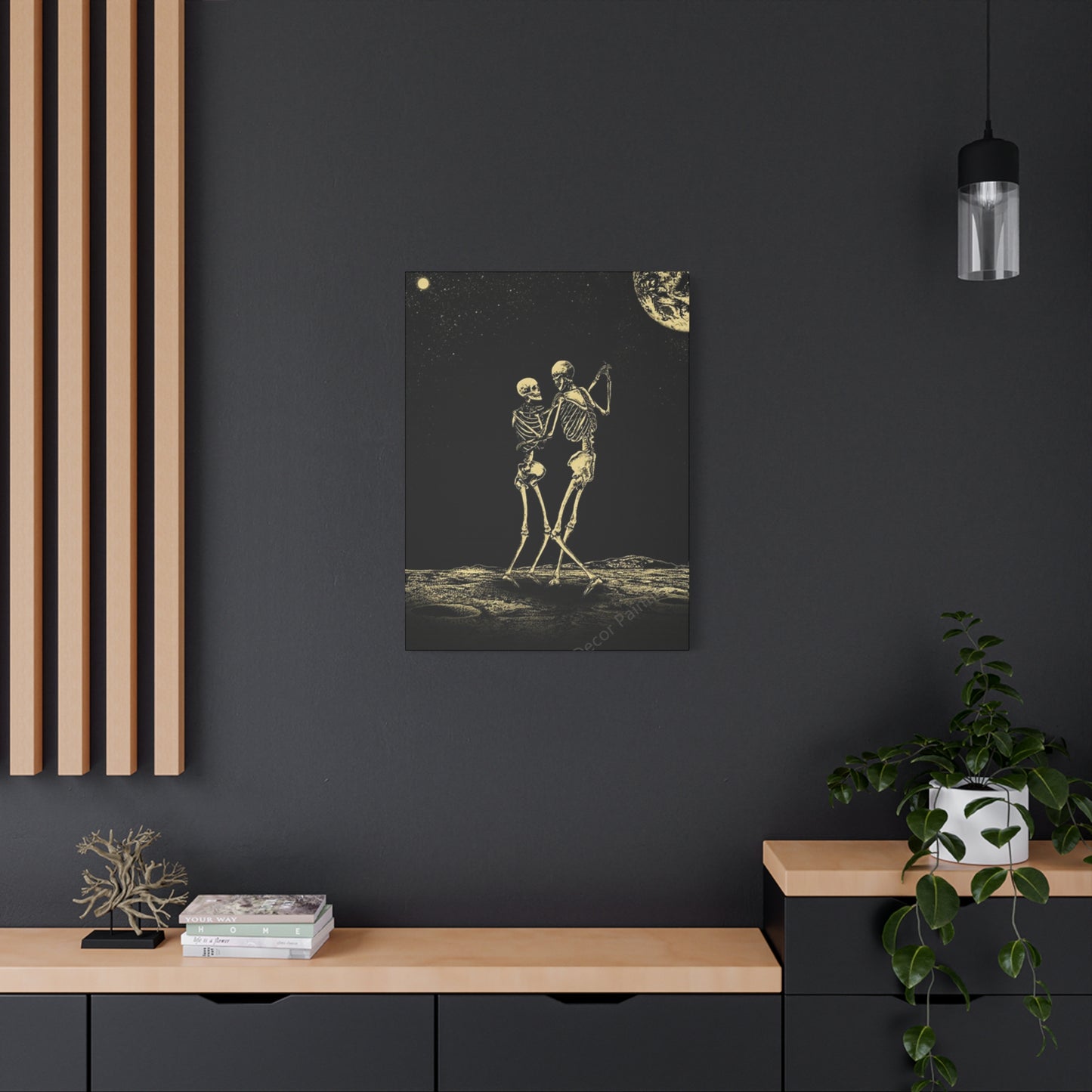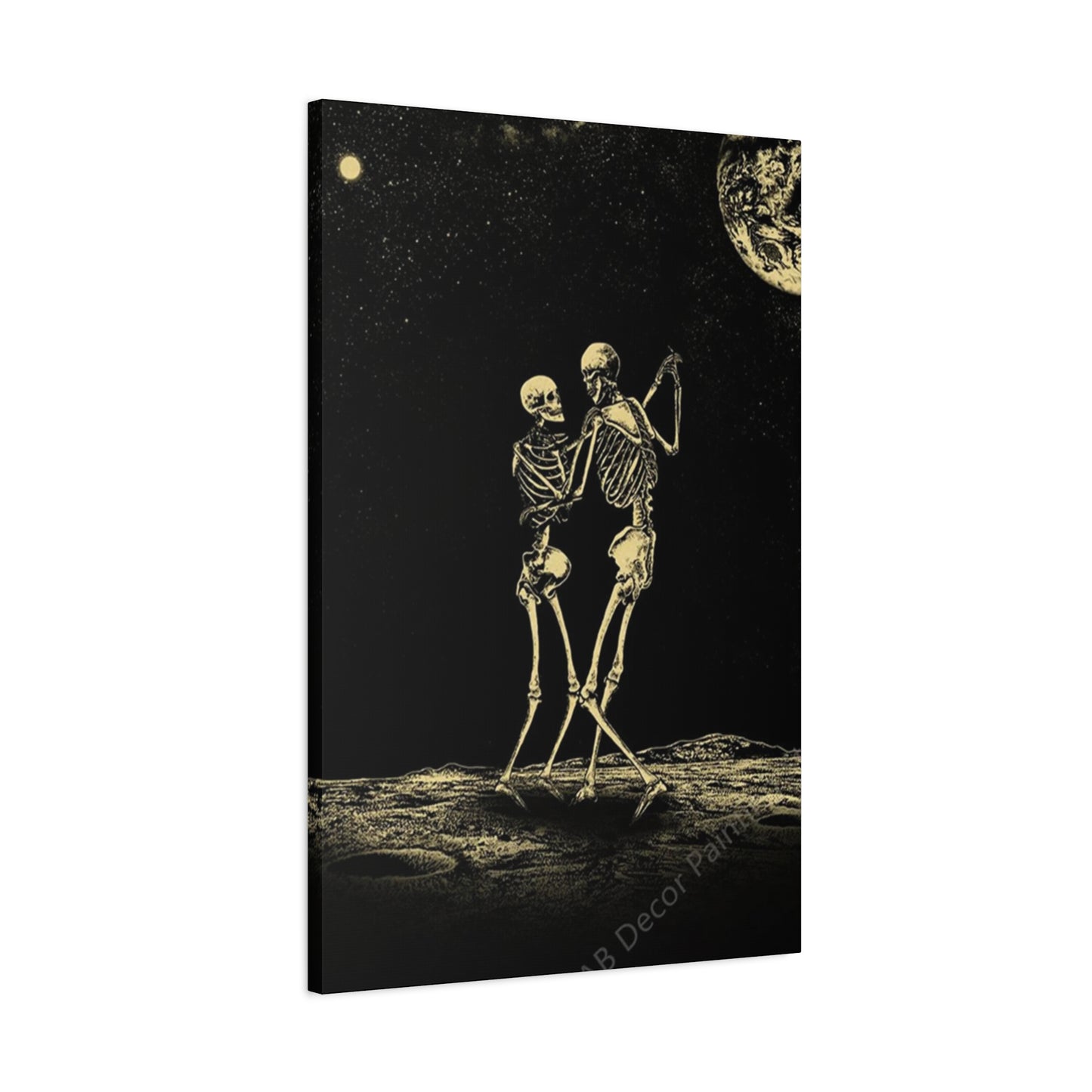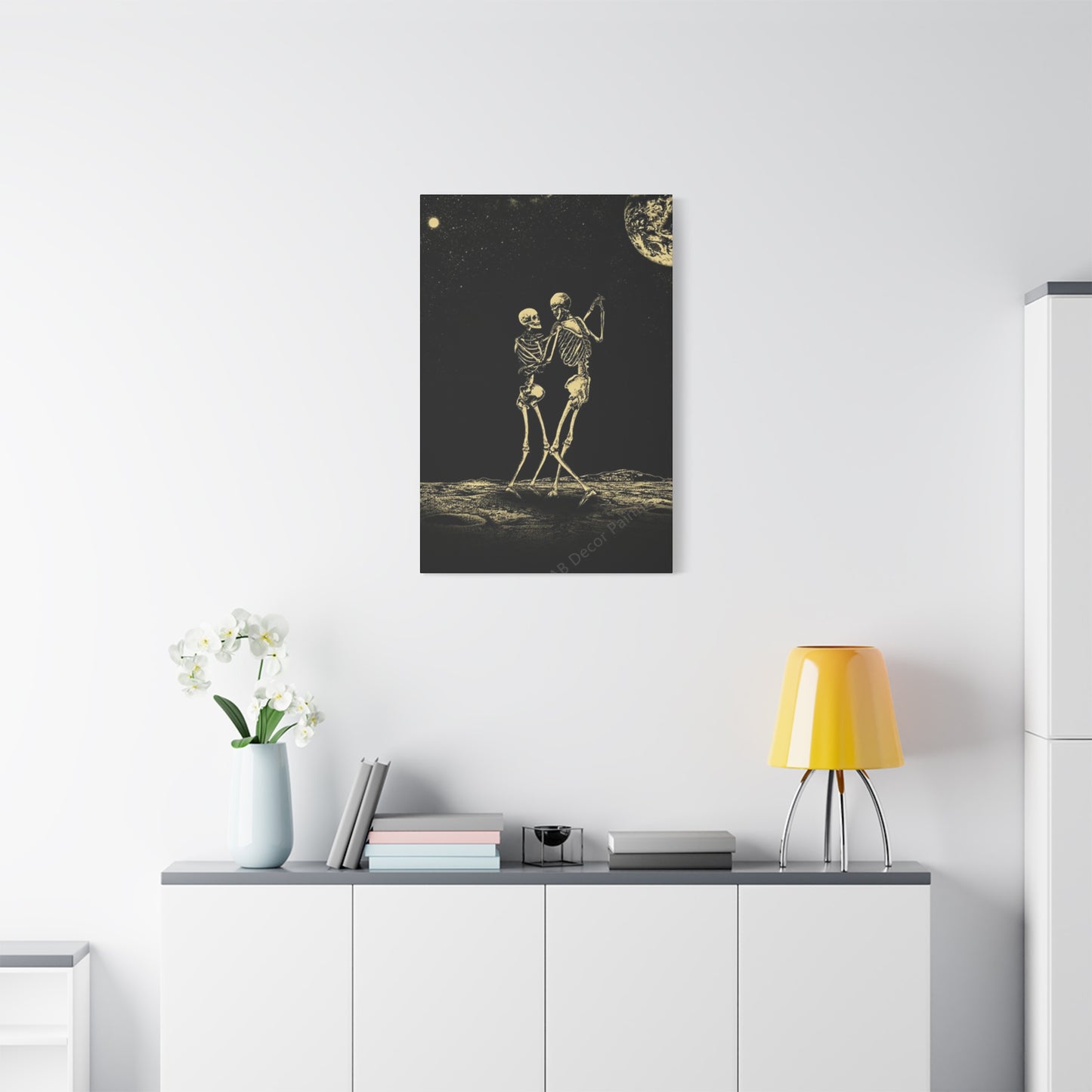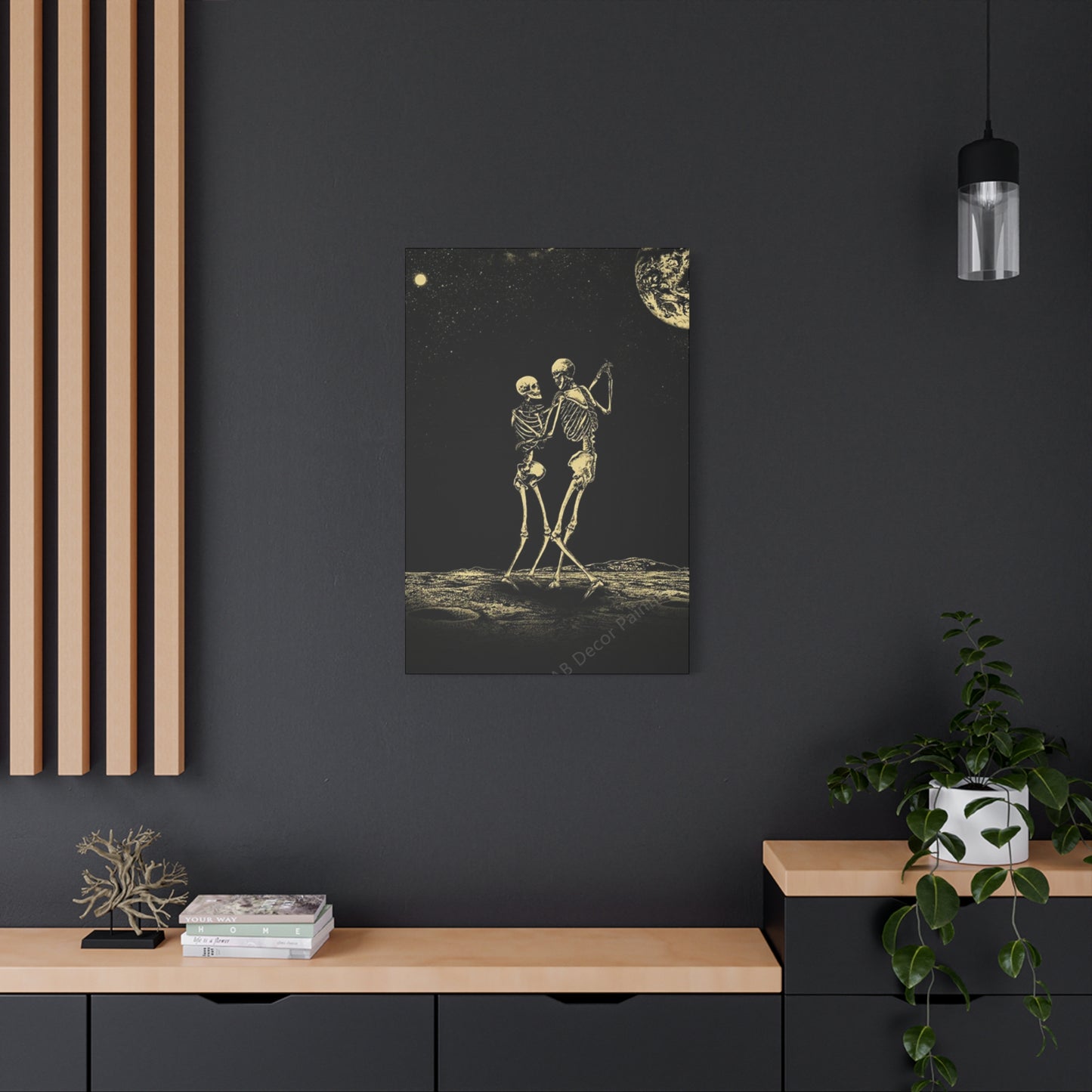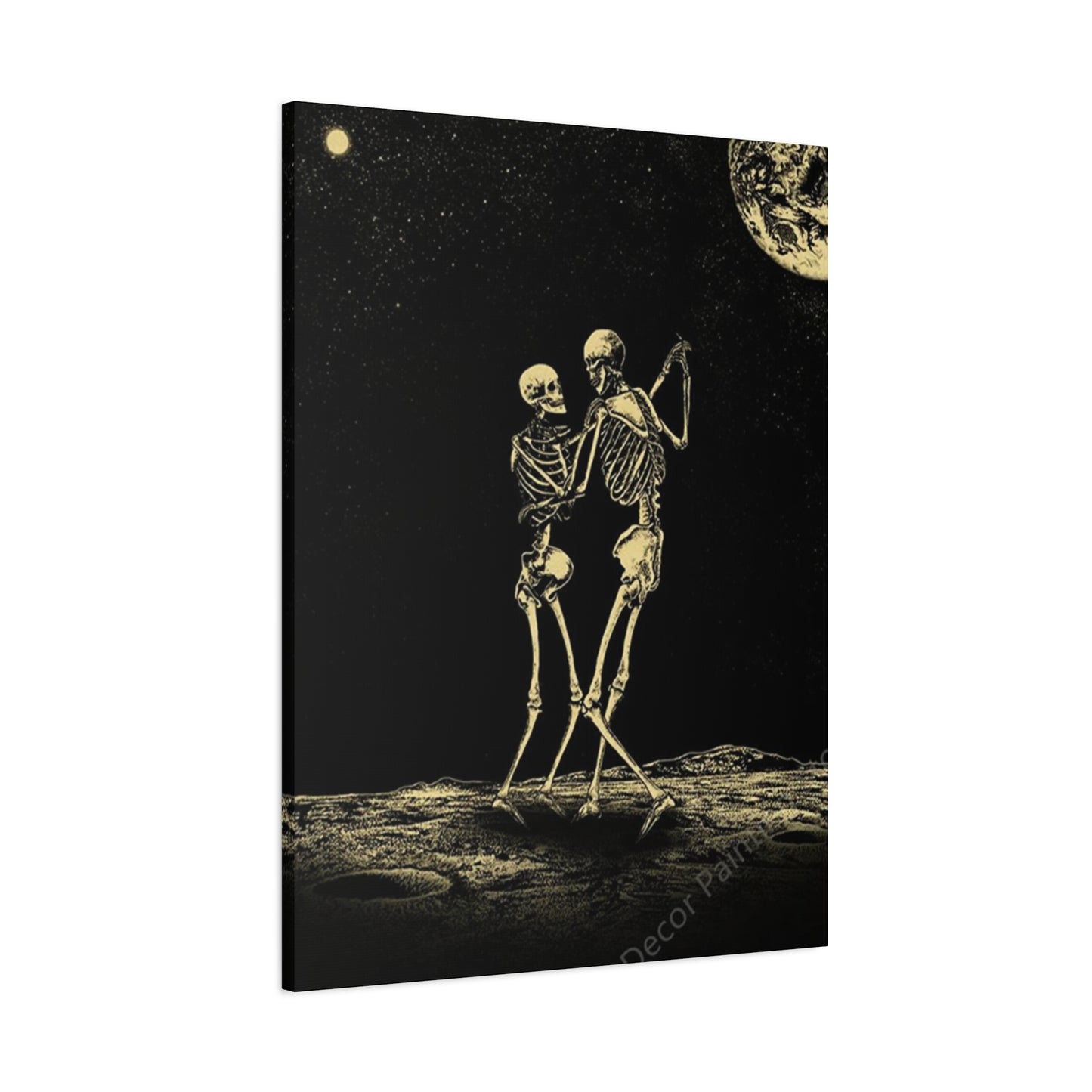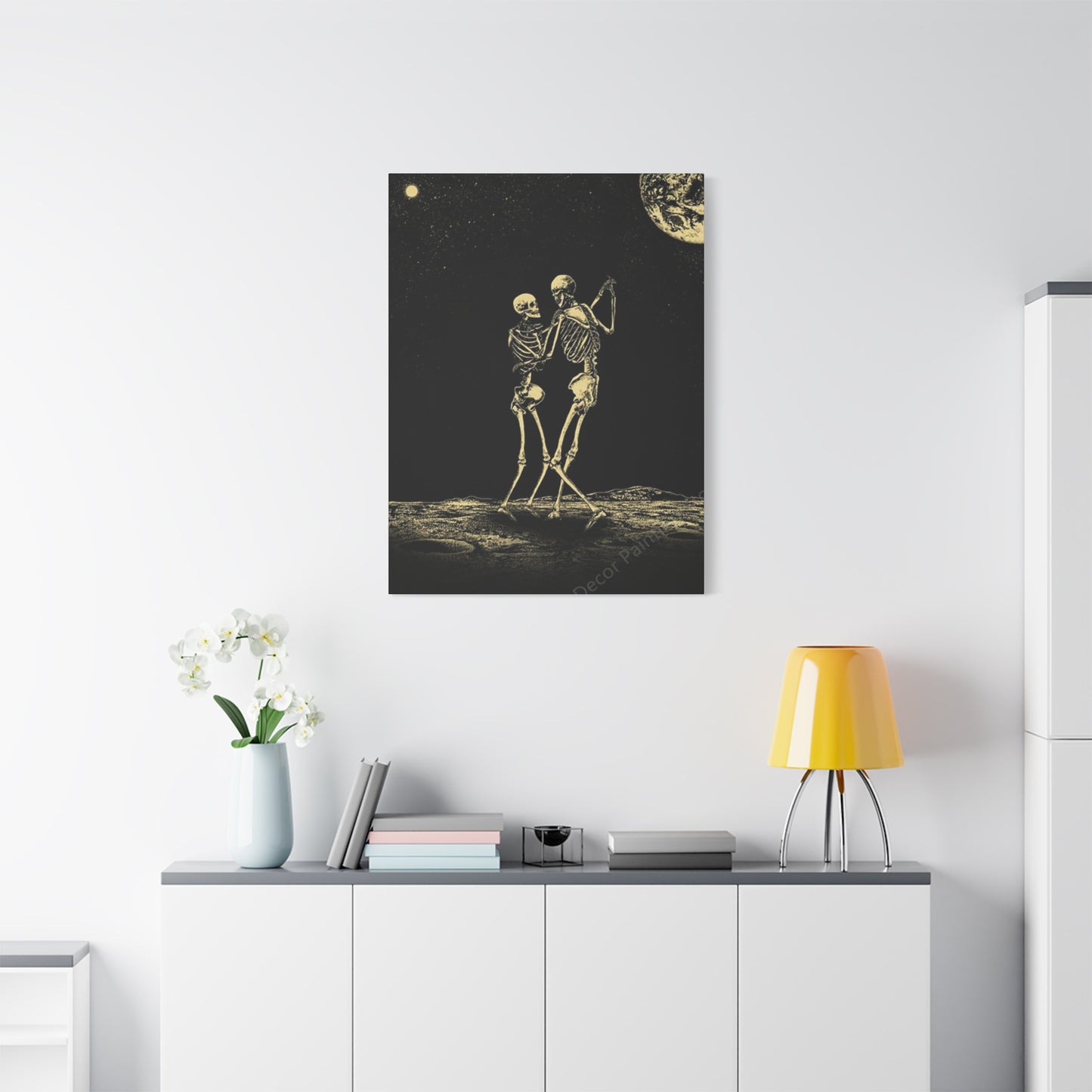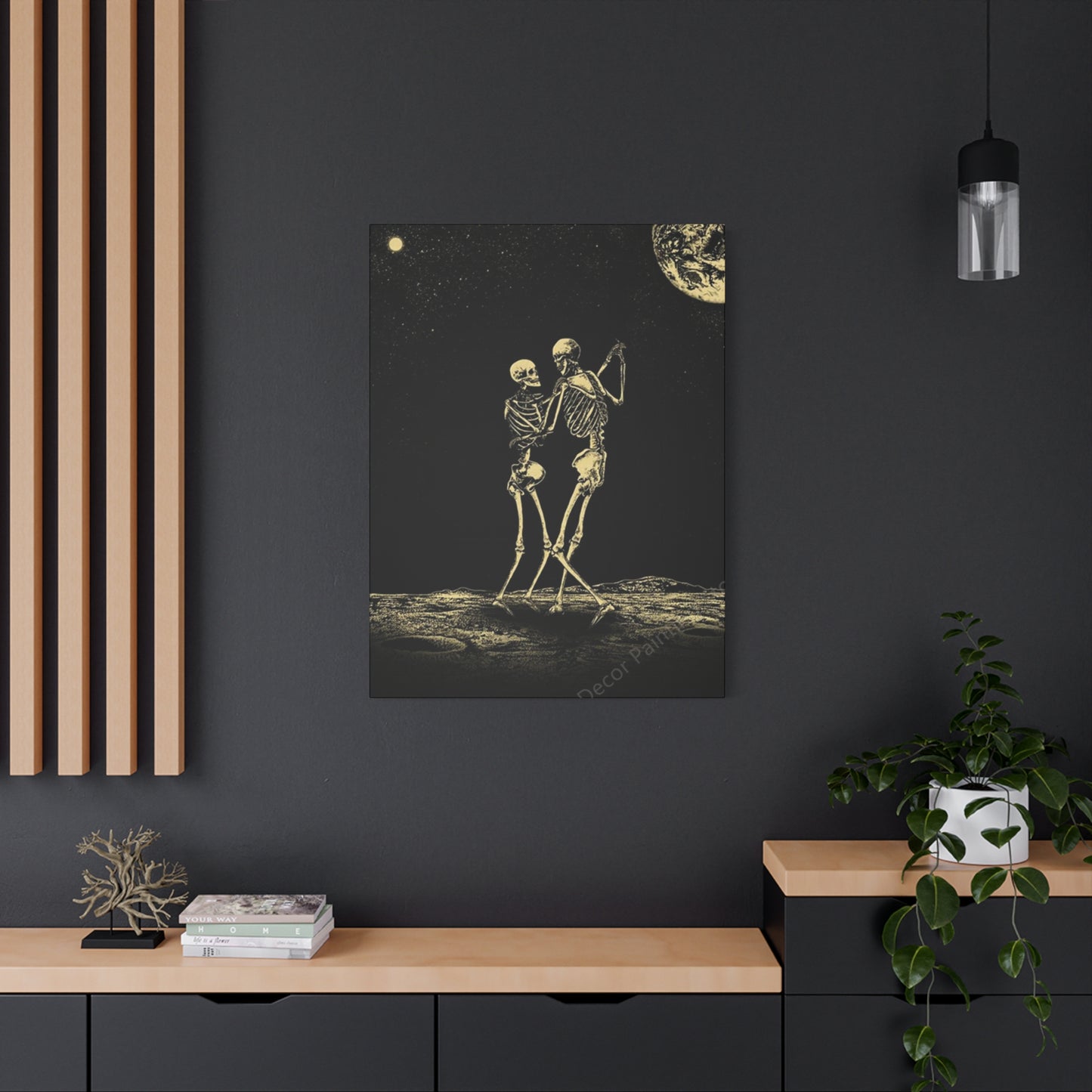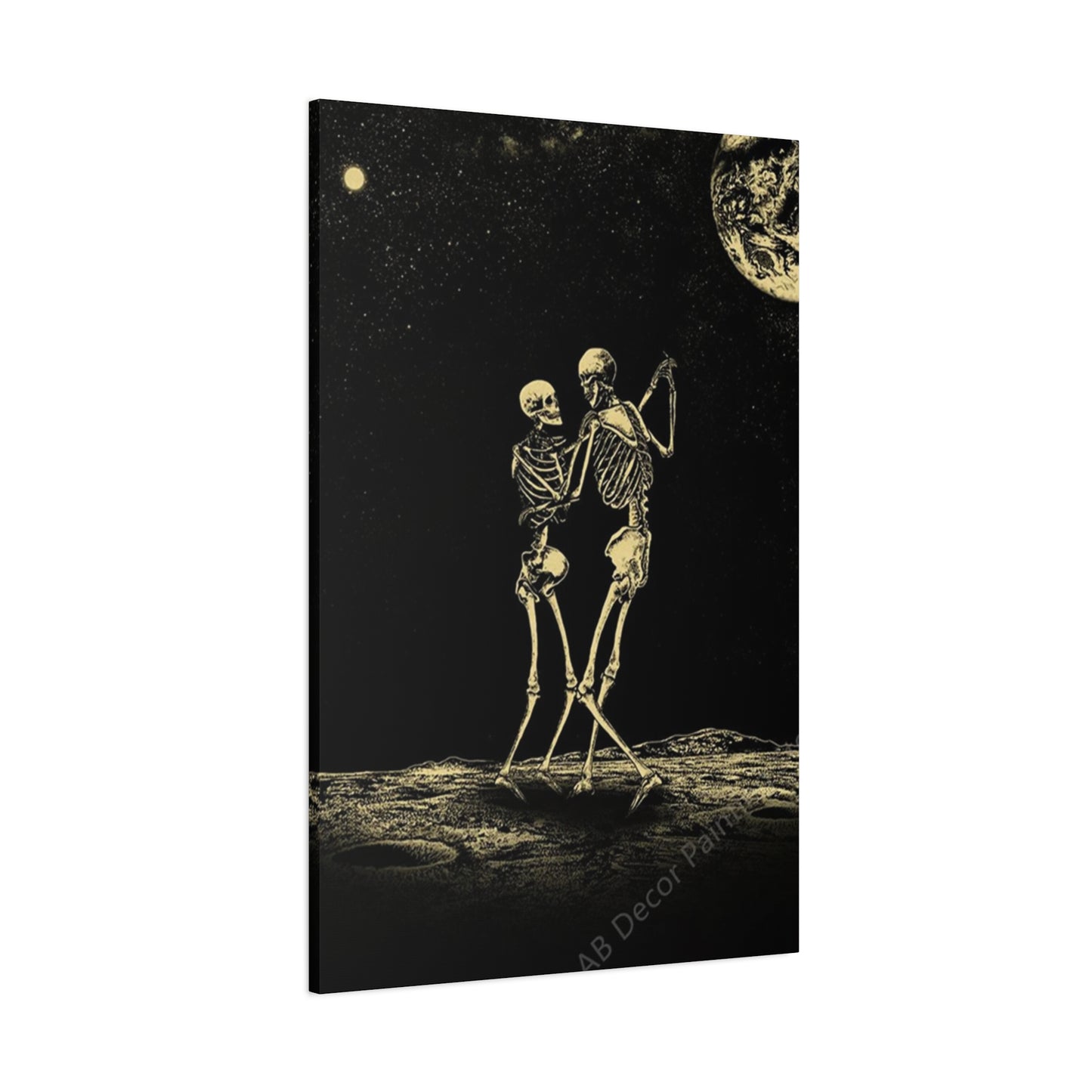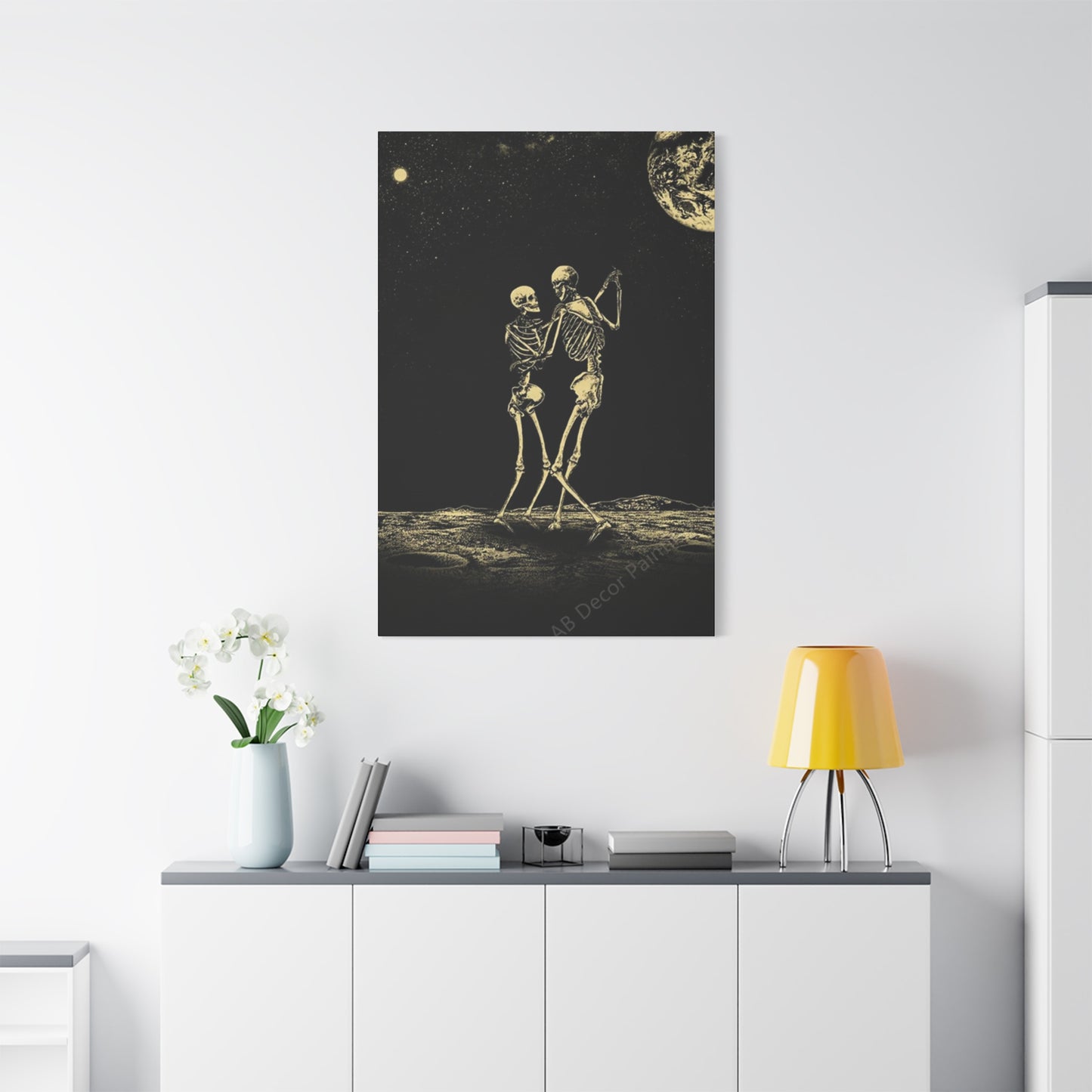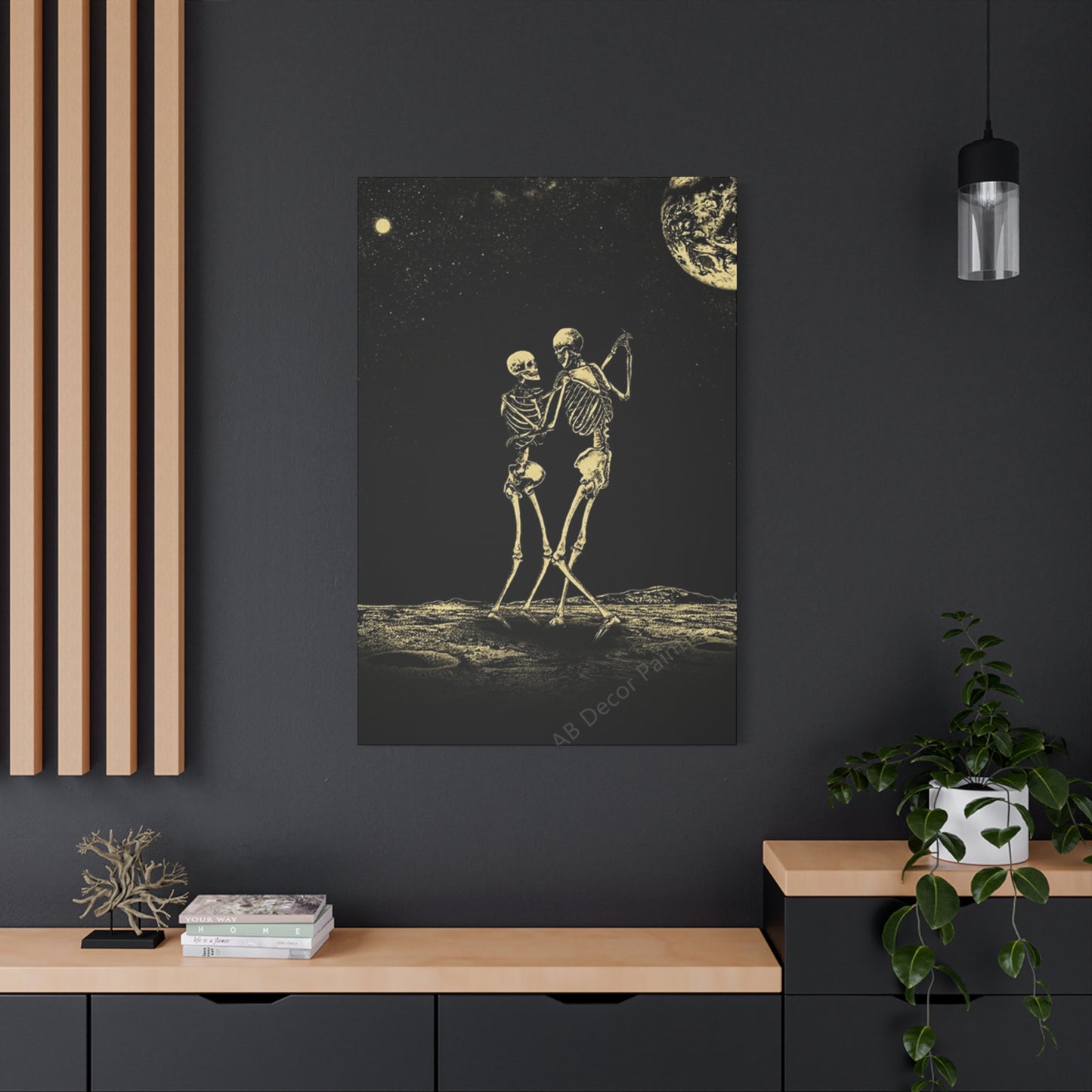Dancing Skeleton Moon Wall Art: Cosmic Expression Through Artistic Freedom
The mesmerizing combination of skeletal figures dancing beneath celestial moonlight has captured the imagination of artists and art enthusiasts worldwide. This distinctive artistic theme represents a powerful fusion of mortality, celebration, and cosmic wonder that resonates deeply with contemporary culture. Dancing skeleton moon wall art transcends traditional boundaries between macabre and whimsical, creating visually striking pieces that spark conversation and contemplation in any environment.
The popularity of dancing skeleton moon wall art stems from its ability to simultaneously embrace life's fleeting nature while celebrating existence itself. These compelling artworks feature skeletal figures in various poses of joy and movement, set against dramatic lunar backdrops that evoke mystery and enchantment. The juxtaposition creates a unique visual narrative that appeals to individuals seeking artwork that challenges conventional aesthetics while maintaining an approachable, often playful quality.
Contemporary artists have embraced this theme as a vehicle for exploring themes of liberation, transformation, and the cyclical nature of existence. The dancing skeleton serves as a metaphor for freedom from earthly constraints, while the moon represents the eternal cycle of renewal and change. This powerful symbolism has made dancing skeleton moon wall art particularly popular among younger demographics who appreciate its blend of gothic sensibility and celebratory spirit.
The artistic movement surrounding dancing skeleton moon imagery draws inspiration from various cultural traditions, including Mexican Día de los Muertos celebrations, medieval danse macabre motifs, and modern gothic aesthetics. These influences combine to create artwork that feels both timeless and thoroughly contemporary, making it suitable for diverse decorative contexts from bohemian living rooms to modern bedrooms.
Captivating Appeal of Skeleton Lunar Dance Artwork
The magnetic draw of skeleton lunar dance artwork lies in its ability to transform typically somber imagery into something unexpectedly joyful and life-affirming. These pieces challenge viewers' preconceptions about death and darkness, instead presenting them as integral parts of life's grand celebration. The skeletal figures, rather than appearing frightening or morbid, dance with abandon beneath the moon's gentle glow, suggesting that true freedom comes from accepting all aspects of existence.
Artists working in this genre often employ vibrant colors and dynamic compositions to emphasize the celebratory nature of their subjects. Purple and blue moonlit skies contrast beautifully with white or cream-colored bones, while splashes of gold, orange, or silver add warmth and energy to the compositions. This color palette creates artwork that feels both mysterious and inviting, dark yet hopeful.
The technical execution of skeleton lunar dance artwork varies widely among artists, from highly detailed realistic renderings to stylized cartoon-like interpretations. Some artists focus on anatomical accuracy, creating skeletons that move with realistic grace and precision, while others embrace more abstract or expressionistic approaches that emphasize emotion and movement over literal representation. This diversity ensures that collectors can find pieces that match their personal aesthetic preferences and decorative needs.
The lunar element in these compositions serves multiple artistic functions beyond mere backdrop. The moon often appears as a spotlight, illuminating the dancing figures and creating dramatic shadows that add depth and dimension to the artwork. Some artists incorporate lunar phases to suggest the passage of time or the cyclical nature of existence, while others use the moon as a symbolic portal or gateway between earthly and celestial realms.
Many contemporary pieces in this genre incorporate elements of surrealism and fantasy, featuring impossible architectural settings, floating objects, or otherworldly landscapes that enhance the dreamlike quality of the compositions. These fantastical elements help viewers suspend disbelief and enter into the magical world depicted in the artwork, creating a more immersive and emotionally engaging experience.
The popularity of skeleton lunar dance artwork has been amplified by social media platforms, where these visually striking images perform particularly well. The high contrast and dramatic compositions translate effectively to small screens, while the symbolic content provides rich material for discussion and interpretation among online communities interested in art, spirituality, and alternative aesthetics.
Exploring Symbolic Meanings in Moonlit Skeletal Art
Moonlit skeletal art operates on multiple symbolic levels, creating rich layers of meaning that reward careful contemplation and analysis. At its most fundamental level, the dancing skeleton represents the triumph of spirit over flesh, suggesting that true essence transcends physical mortality. The skeletal form, stripped of worldly concerns and earthly attachments, dances freely beneath the eternal moon, embodying complete liberation from material constraints.
The moon itself carries profound symbolic weight across cultures and throughout history. In the context of skeleton dance art, the moon often represents the cyclical nature of existence, the eternal dance between light and shadow, and the mysterious forces that govern life and death. Its gentle illumination transforms what might otherwise be a frightening scene into something beautiful and contemplative, suggesting that death itself might be viewed as a natural and even beautiful part of existence.
The act of dancing within these compositions adds another layer of symbolic meaning. Dance represents joy, celebration, freedom of expression, and the fundamental human desire to move in harmony with natural rhythms. When skeletal figures engage in dance, they suggest that celebration and joy are not dependent on physical form but are essential aspects of existence that transcend mortality. This interpretation aligns with various spiritual and philosophical traditions that view death as a transition rather than an ending.
Color symbolism plays a crucial role in conveying meaning within moonlit skeletal art. Cool blues and purples often dominate the palette, representing tranquility, mystery, and spiritual depth. When warmer colors appear, they typically highlight specific elements like flowing garments, musical instruments, or decorative details that emphasize the celebratory nature of the scene. The contrast between cool and warm tones creates visual interest while reinforcing the artwork's thematic balance between contemplation and celebration.
Many artists incorporate additional symbolic elements into their moonlit skeletal compositions to deepen their meaning and visual impact. Flowers, particularly roses or marigolds, might appear to reference specific cultural traditions like Día de los Muertos, where death is celebrated rather than mourned. Musical instruments suggest the harmony of existence and the importance of creativity in both life and death. Flowing fabrics or ethereal garments hint at the soul's continuation beyond physical form.
The positioning and poses of skeletal figures within these compositions often carry specific symbolic meanings. Figures with arms raised toward the moon might represent aspiration and spiritual reaching, while those engaged in partner dances could symbolize eternal love or the interconnectedness of all existence. Solo dancers might represent individual spiritual journeys, while group compositions often emphasize community and shared experience in facing mortality.
Some contemporary artists use moonlit skeletal imagery to address modern anxieties about mortality, environmental destruction, or social isolation. In these contexts, the dancing skeletons might represent resilience in the face of adversity or the importance of finding joy despite challenging circumstances. The moon serves as a symbol of hope and continuity, suggesting that beauty and wonder persist even in difficult times.
Optimal Placement Strategies for Lunar Skeleton Artwork
Selecting the perfect location for lunar skeleton artwork requires careful consideration of both aesthetic impact and thematic appropriateness. These distinctive pieces work best in environments where their symbolic depth can be appreciated and their visual drama properly showcased. The key to successful placement lies in understanding how the artwork's themes and visual elements interact with the surrounding environment and the room's intended function.
Living areas provide excellent opportunities for displaying lunar skeleton artwork, particularly in homes with eclectic or bohemian decorative schemes. These pieces work exceptionally well as focal points above sofas, mantels, or entertainment centers, where their dramatic compositions can command attention without overwhelming the room's overall balance. The conversational nature of this artwork makes it ideal for social areas where guests are likely to notice and discuss the piece's unique symbolism and artistic merit.
Bedrooms offer intimate settings for lunar skeleton artwork, particularly in teen or young adult rooms where the themes of freedom, transformation, and self-expression resonate strongly. When placed above beds or on prominent walls, these pieces can serve as daily reminders of life's preciousness and the importance of embracing authentic self-expression. The contemplative nature of the imagery also makes it suitable for meditation or relaxation areas within bedrooms.
Home offices and creative workrooms benefit from the inspirational qualities of lunar skeleton artwork. The themes of liberation and creative expression can help motivate artistic endeavors and encourage unconventional thinking. Placement near desks or work areas can provide visual stimulation and serve as a reminder to approach projects with both passion and perspective on life's larger meanings.
Hallways and transitional areas offer unique opportunities for lunar skeleton artwork, as these locations metaphorically align with the artwork's themes of passage and transformation. Long hallway walls can accommodate larger pieces or series of related works that create a cohesive visual narrative as viewers move through the area. The dramatic lighting effects often featured in these artworks can help brighten darker hallway areas while adding visual interest to otherwise neglected portions of the home.
Dining areas present interesting possibilities for lunar skeleton artwork, particularly in homes where meals are viewed as celebrations of life and togetherness. The festive aspects of dancing skeleton imagery can enhance the convivial atmosphere of dining rooms while providing thought-provoking visual interest for guests. Care should be taken to ensure that the artwork's themes align with the homeowner's comfort level regarding mortality imagery in eating areas.
Entertainment rooms, game rooms, and recreational areas often provide ideal settings for more playful interpretations of lunar skeleton artwork. These environments naturally accommodate unconventional art choices, and the celebratory aspects of dancing skeleton imagery can enhance the fun, relaxed atmosphere of recreational areas. Home theaters particularly benefit from the dramatic visual impact of these pieces, which can add personality to otherwise technology-focused environments.
Lighting considerations play a crucial role in the effective placement of lunar skeleton artwork. These pieces often feature dramatic contrasts between light and shadow, which can be enhanced or diminished depending on the surrounding lighting conditions. Artwork featuring prominent moon elements benefits from subtle accent lighting that mimics the lunar illumination depicted within the piece. Avoiding harsh direct lighting prevents glare while maintaining the mysterious atmosphere that makes these artworks so compelling.
Whimsical Lunar Skeleton Artistic Expressions
Whimsical approaches to lunar skeleton art transform potentially somber subjects into delightfully engaging and often humorous compositions. These interpretations emphasize the playful possibilities inherent in the dancing skeleton theme, creating artwork that appeals to viewers who appreciate both gothic aesthetics and lighthearted creativity. The key to successful whimsical lunar skeleton art lies in balancing the inherent drama of the skeletal imagery with elements of surprise, humor, and pure visual enjoyment.
Cartoon-style interpretations represent one popular approach to whimsical lunar skeleton art. These pieces feature simplified skeletal figures with exaggerated proportions, expressive poses, and often anthropomorphic characteristics that make them more approachable and less intimidating. The cartoon aesthetic allows artists to incorporate elements of slapstick humor, such as skeletons losing bones mid-dance or engaging in comically elaborate dance moves that would be impossible for living beings.
Color choices in whimsical lunar skeleton art often depart from traditional gothic palettes in favor of brighter, more saturated hues. Pink and purple moons, rainbow-colored bones, or multicolored cosmic backgrounds create a festive atmosphere that emphasizes celebration over contemplation. These unexpected color combinations help viewers approach the artwork with curiosity and delight rather than apprehension or solemnity.
Many whimsical interpretations incorporate elements of popular culture, including references to famous dance moves, musical genres, or entertainment media. Skeletons might be depicted performing breakdancing moves, ballroom dancing, or even contemporary dance styles like hip-hop or salsa. These cultural references make the artwork more relatable and accessible to younger audiences while maintaining the core themes of freedom and celebration.
Animal companions frequently appear in whimsical lunar skeleton compositions, adding elements of charm and unexpected humor. Skeletal cats, dogs, birds, or even more exotic creatures might join the dance, creating multi-species celebrations that emphasize the universal nature of joy and movement. These animal elements often serve as bridges between the supernatural aspects of the skeleton imagery and the natural world, making the compositions feel more connected to everyday experience.
Seasonal variations provide rich possibilities for whimsical lunar skeleton art. Halloween-themed pieces might incorporate traditional autumn elements like pumpkins, fallen leaves, or harvest moons, while spring versions could feature flowering branches or butterflies. Winter compositions might show skeletons ice skating or building snowmen, while summer pieces could depict beach dancing or outdoor festivals. These seasonal adaptations make the artwork more versatile for year-round display.
Interactive or narrative elements enhance the whimsical appeal of lunar skeleton art. Some pieces depict skeletons engaged in activities beyond dancing, such as playing musical instruments, painting, cooking, or engaging in various hobbies. These additional activities suggest rich inner lives and personalities for the skeletal characters, making them more relatable and endearing to viewers.
Technology integration offers contemporary artists new possibilities for creating whimsical lunar skeleton art. Digital artists can incorporate animated elements, changing colors, or interactive features that respond to viewer movement or touch. Augmented reality applications can bring static artwork to life, allowing viewers to see the skeletons actually dancing or hear accompanying music when viewed through mobile devices.
The appeal of whimsical lunar skeleton art extends beyond pure entertainment value. These pieces often serve as conversation starters, ice breakers, or mood enhancers in social settings. Their ability to address serious themes through playful imagery makes them particularly effective for environments where both comfort and intellectual engagement are desired.
Budget-Friendly Lunar Skeleton Print Options
Accessing high-quality lunar skeleton artwork doesn't require a substantial financial investment, thanks to the wide variety of budget-friendly print options available to contemporary collectors. The democratization of art through digital printing technology has made it possible for art enthusiasts to enjoy sophisticated lunar skeleton compositions at prices that fit virtually any budget. Understanding the various print options and their relative advantages helps collectors make informed decisions that maximize both aesthetic impact and value.
Digital prints represent the most accessible entry point for lunar skeleton art collection. These reproductions capture the full color range and detail of original artworks while remaining affordable enough for multiple purchases or experimentation with different pieces. High-quality digital printing technology can reproduce subtle color gradations and fine details that make lunar skeleton art so visually compelling, ensuring that budget-conscious buyers don't sacrifice image quality for affordability.
Print-on-demand services have revolutionized access to lunar skeleton artwork by eliminating inventory costs and allowing artists to offer their work at lower prices. These platforms connect artists directly with consumers, often resulting in more competitive pricing than traditional gallery representation. Many artists offer exclusive designs through print-on-demand platforms, providing collectors with unique pieces that aren't available through conventional retail channels.
Paper quality significantly impacts both the appearance and longevity of budget-friendly prints. While premium papers command higher prices, mid-range options often provide excellent results for lunar skeleton artwork. Matte finish papers reduce glare and provide rich color saturation that works particularly well with the dramatic lighting effects common in this art style. Glossy finishes can enhance color vibrancy but may create reflection issues depending on display location and lighting conditions.
Size considerations play a crucial role in maximizing the impact of budget-friendly lunar skeleton prints. Larger sizes generally provide more dramatic impact but cost significantly more to print and frame. Medium sizes often represent the best value proposition, providing sufficient visual presence while remaining affordable. Collectors can also consider purchasing multiple smaller prints to create gallery walls or themed groupings that provide greater overall impact than single large pieces.
Poster formats offer extremely budget-friendly options for lunar skeleton art, though they typically require separate framing investments. Many online retailers offer high-quality poster prints of lunar skeleton artwork at prices that make collection building feasible for students, young professionals, or anyone working within tight budget constraints. The key to success with poster formats lies in investing in appropriate framing that protects the print while enhancing its visual presentation.
Group purchasing or bulk ordering can significantly reduce per-unit costs for lunar skeleton prints. Art enthusiasts might coordinate purchases with friends, family members, or online communities to take advantage of volume discounts. Some artists offer package deals for multiple prints, allowing collectors to acquire coordinated sets or variations on themes at reduced overall costs.
Seasonal sales and promotional events provide opportunities to acquire higher-quality lunar skeleton prints at reduced prices. Many online art retailers offer significant discounts during holiday periods, end-of-year clearances, or special promotional events. Signing up for newsletters or following preferred artists on social media helps collectors stay informed about upcoming sales and special offers.
DIY framing approaches can substantially reduce the total cost of displaying lunar skeleton prints. Learning basic framing techniques and purchasing materials in bulk allows collectors to achieve professional-looking presentations at fraction of custom framing costs. Many hardware and craft stores offer framing workshops or online tutorials that make DIY framing accessible to beginners.
Creative DIY Lunar Skeleton Artwork Projects
Creating original lunar skeleton artwork provides an engaging and personally rewarding alternative to purchasing existing pieces. DIY approaches allow artists to customize every aspect of their creations, from color choices and compositions to size and medium selection. The process of creating lunar skeleton art can be as fulfilling as displaying the finished pieces, offering opportunities for creative expression, skill development, and personal interpretation of this compelling artistic theme.
Painting projects represent the most traditional approach to DIY lunar skeleton artwork. Acrylic paints offer versatility, quick drying times, and easy cleanup that make them ideal for beginners and experienced artists alike. Canvas boards or stretched canvases provide suitable painting surfaces, while the dramatic contrasts typical of lunar skeleton art make them forgiving subjects for artists still developing their technical skills. Starting with simple compositions featuring single dancing figures against moon-lit backgrounds allows artists to master basic techniques before attempting more complex multi-figure scenes.
Mixed media approaches open exciting possibilities for DIY lunar skeleton artwork. Combining paint with collage elements, fabric scraps, metallic leafing, or textural materials can create unique effects that distinguish homemade pieces from commercial alternatives. Glow-in-the-dark paints add interactive elements that enhance the mysterious atmosphere of lunar skeleton compositions, creating artwork that transforms depending on lighting conditions throughout the day.
Digital art creation has become increasingly accessible to amateur artists thanks to user-friendly software and online tutorials. Tablet-based art applications allow artists to create sophisticated lunar skeleton compositions using digital brushes, layers, and effects that would be difficult or impossible to achieve with traditional media. The ability to easily experiment with color choices, compositional arrangements, and special effects makes digital creation particularly appealing for perfectionists who want to refine their work extensively.
Photography-based projects offer alternative approaches to creating original lunar skeleton artwork. Artists might photograph actual skeleton models or figurines in carefully constructed lunar landscapes, using lighting techniques to create dramatic effects. Combining multiple photographs through digital editing can produce surreal compositions that would be difficult to achieve through painting alone. This approach particularly appeals to artists who enjoy the technical aspects of photography and digital manipulation.
Sculptural interpretations of lunar skeleton themes provide three-dimensional alternatives to traditional flat artwork. Wire sculptures, clay figures, or assemblage pieces using found objects can create compelling lunar skeleton compositions suitable for display on shelves, mantels, or pedestals. These dimensional pieces often serve as conversation starters while demonstrating the versatility of the lunar skeleton theme beyond traditional painting formats.
Collaborative family or group projects can make DIY lunar skeleton artwork creation more social and engaging. Parents might work with children to create age-appropriate versions of lunar skeleton art that emphasize the playful rather than gothic aspects of the theme. Art therapy groups or community centers might organize lunar skeleton creation workshops that combine artistic expression with discussions about mortality, celebration, and personal growth.
Seasonal adaptation projects allow DIY artists to create multiple variations on lunar skeleton themes throughout the year. Halloween versions might incorporate traditional autumn elements, while spring interpretations could feature flowering branches or butterflies. Creating seasonal variations provides ongoing creative challenges while ensuring that the resulting artwork remains fresh and interesting throughout the year.
The process of creating DIY lunar skeleton artwork often proves as valuable as the finished pieces. Many artists report that working with mortality themes in creative contexts helps them develop healthier perspectives on death and impermanence. The act of transforming potentially frightening imagery into something beautiful and celebratory can be therapeutically beneficial while producing artwork with deep personal meaning.
Contrasts Between Shadow and Illumination in Lunar Skeletal Art
The interplay between shadow and illumination forms the visual foundation of compelling lunar skeletal art, creating dramatic contrasts that give these compositions their distinctive emotional impact and aesthetic power. Masterful use of light and shadow transforms simple skeletal figures into complex artistic statements that capture viewers' attention and hold their interest through subtle gradations, bold contrasts, and carefully orchestrated visual rhythms that guide the eye through the composition.
Chiaroscuro techniques, borrowed from classical painting traditions, find new expression in contemporary lunar skeletal art. The stark white of skeletal bones against deep blue or purple night skies creates natural opportunities for dramatic light-dark contrasts that emphasize form, movement, and emotional content. Artists working in this tradition often use single light sources, typically the moon itself, to create consistent shadow patterns that unify the composition while adding depth and dimensionality to otherwise flat surfaces.
Rim lighting effects, where light sources behind or beside subjects create bright outlines around darkened forms, prove particularly effective in lunar skeletal compositions. This technique separates dancing figures from background elements while creating ethereal, otherworldly effects that enhance the supernatural aspects of the imagery. Rim lighting can suggest spiritual energy, transformation, or transcendence while maintaining the mysterious atmosphere that makes lunar skeletal art so compelling.
Cast shadows function as compositional elements in their own right, often creating secondary patterns and rhythms that complement the primary subjects. Dancing skeleton figures might cast shadows that extend the sense of movement beyond the figures themselves, or create abstract shapes that add visual interest to otherwise empty ground areas. Some artists use cast shadows to suggest additional unseen figures or to create symbolic imagery that reinforces the artwork's thematic content.
Reflected light from lunar sources often illuminates architectural elements, landscape features, or atmospheric effects that provide context for the primary skeletal subjects. Moonlight reflecting off water, stone surfaces, or metallic objects can create secondary light sources that add complexity and visual interest to compositions while maintaining the overall nocturnal atmosphere. These reflected light sources often use cooler color temperatures that contrast with any warmer accent colors in the composition.
Atmospheric perspective techniques help create sense of depth and distance in lunar skeletal compositions. Background elements rendered in lighter values and reduced contrast appear more distant, while foreground elements maintain strong contrast and sharp detail. This technique can suggest vast cosmic scales that dwarf the dancing figures, emphasizing their place within larger universal contexts while maintaining their individual importance within the composition.
Color temperature contrasts between warm and cool light sources add emotional depth to lunar skeletal artwork. Cool blue or purple moonlight might dominate the overall composition, while warmer yellow or orange accent lights from candles, fires, or magical sources create focal points and suggest different emotional qualities within the same piece. These temperature contrasts can guide viewers' emotional responses while adding visual complexity that rewards careful observation.
Silhouette effects, where figures appear as dark shapes against bright backgrounds, offer simplified but powerful approaches to lunar skeletal art. These high-contrast compositions emphasize gesture, pose, and overall form while reducing distracting details that might compete with the artwork's primary emotional impact. Silhouette approaches work particularly well for artwork intended to be viewed from distances or in contexts where immediate recognition is more important than detailed observation.
The psychological impact of light-shadow contrasts in lunar skeletal art cannot be understated. These dramatic visual effects tap into fundamental human responses to light and darkness, safety and mystery, known and unknown. By skillfully manipulating these contrasts, artists can evoke specific emotional responses while creating artwork that operates on both conscious and unconscious levels of viewer experience.
Enhancing Teen Room Environments with Lunar Skeleton Art
Teen bedrooms present unique opportunities for incorporating lunar skeleton art that reflects young people's developing identities, aesthetic preferences, and desire for self-expression. These personal environments serve as canvases for exploring individual taste while creating sanctuary-like retreats that support both relaxation and creative thinking. Lunar skeleton art appeals to teenagers' natural attraction to themes of transformation, rebellion against conventional aesthetics, and fascination with life's deeper mysteries.
Bedroom wall placement requires careful consideration of both visual impact and daily functionality. Lunar skeleton artwork positioned above beds serves as focal points that greet teens upon waking and provide contemplative imagery before sleep. The themes of liberation and celebration inherent in dancing skeleton imagery can serve as daily reminders to embrace authenticity and creative expression throughout adolescent challenges and transitions.
Color coordination between lunar skeleton artwork and existing room elements helps create cohesive environments that feel intentionally designed rather than randomly assembled. Many teens gravitate toward darker color palettes that naturally complement the nocturnal themes of lunar skeleton art. Deep purples, navy blues, and charcoal grays provide sophisticated backgrounds that make artwork pop while maintaining the mysterious atmosphere that appeals to teenage sensibilities.
Lighting design plays a crucial role in maximizing the impact of lunar skeleton art in teen environments. String lights, colored LED strips, or specialty accent lights can enhance the artwork's nocturnal themes while providing functional illumination for studying or socializing. Some teens enjoy creating lighting effects that change throughout the day, allowing their artwork to take on different moods and appearances depending on the time and activity.
Gallery wall arrangements allow teens to combine lunar skeleton pieces with other artwork, photographs, or memorabilia that reflect their evolving interests and relationships. These curated collections provide opportunities for creative arrangement and rearrangement as tastes change and new pieces are acquired. The flexibility of gallery walls makes them particularly suitable for teens who enjoy frequently updating their personal environments.
Size considerations must balance visual impact with practical room constraints. Many teen bedrooms have limited wall area due to furniture placement, windows, and storage needs. Medium-sized prints often provide the best compromise between presence and practicality, while series of smaller coordinated pieces can create impact without overwhelming compact areas. Removable adhesive mounting systems allow for easy repositioning as room layouts change.
Thematic integration extends beyond artwork to encompass accessories, bedding, and decorative elements that reinforce the lunar skeleton aesthetic. Moon-shaped mirrors, celestial-themed bedding, or skeleton-motif accessories can create immersive environments that reflect teens' commitment to their chosen aesthetic while maintaining functionality for daily life activities.
The psychological benefits of personalizing teen environments with meaningful artwork cannot be overstated. Lunar skeleton art provides opportunities for young people to explore complex themes of identity, mortality, and celebration in safe, private contexts. The rebellious aspects of gothic imagery combined with the life-affirming qualities of dance create perfect metaphors for adolescent experiences of challenging conventions while embracing personal growth.
Seasonal updates allow teens to refresh their environments without major redecorating investments. Swapping lunar skeleton pieces or adding seasonal accent elements keeps rooms feeling current and personally relevant as interests and circumstances evolve. This flexibility particularly appeals to teenagers who are still discovering their long-term aesthetic preferences.
Distinctive Lunar Skeleton Artistic Variations
Contemporary artists working with lunar skeleton themes demonstrate remarkable creativity in developing distinctive variations that push beyond conventional gothic imagery. These innovative approaches combine traditional skeletal symbolism with unexpected elements, techniques, and cultural references that create truly original artistic statements. The diversity of contemporary lunar skeleton art ensures that collectors can find pieces that match their specific aesthetic preferences while contributing to the ongoing evolution of this compelling artistic genre.
Steampunk-influenced lunar skeleton art represents one fascinating variation that combines Victorian mechanical aesthetics with traditional dancing skeleton imagery. These pieces feature skeletons adorned with gears, clockwork mechanisms, brass fittings, and other industrial elements that suggest themes of time, mortality, and technological transformation. The contrast between organic bone structures and mechanical additions creates visually striking compositions that appeal to fans of both gothic and science fiction aesthetics.
Art Nouveau styling brings flowing, organic lines and decorative flourishes to lunar skeleton compositions. These pieces often feature elaborate frame-like borders, stylized plant motifs, and elegant typography that transforms potentially stark imagery into sophisticated decorative art. The Art Nouveau approach emphasizes beauty and craftsmanship while maintaining the essential themes of celebration and transcendence that define lunar skeleton art.
Minimalist interpretations strip away decorative elements to focus on essential forms, gestures, and emotional content. These pieces often use limited color palettes, simple compositions, and clean lines to create maximum impact with minimum visual complexity. Minimalist lunar skeleton art appeals to collectors who appreciate subtle sophistication and contemporary design sensibilities while maintaining interest in the genre's symbolic content.
Pop art influences introduce bright colors, commercial imagery, and cultural commentary into lunar skeleton compositions. These pieces might incorporate advertising graphics, celebrity references, or consumer product imagery to create social commentary while maintaining the essential dancing skeleton theme. Pop art approaches often appeal to younger collectors who appreciate the genre's ability to address serious themes through accessible, contemporary visual languages.
Manga and anime styling brings Japanese artistic traditions to lunar skeleton imagery, often featuring exaggerated expressions, dynamic action lines, and characteristic color palettes. These pieces appeal to fans of Japanese popular culture while introducing Eastern artistic sensibilities to traditionally Western gothic themes. The energy and movement typical of manga styling particularly complement the dancing aspects of skeletal imagery.
Photorealistic approaches use extremely detailed rendering techniques to create lunar skeleton artwork that appears almost photographic in its precision and clarity. These pieces often feature elaborate backgrounds, complex lighting effects, and meticulous attention to anatomical accuracy that creates immersive viewing experiences. Photorealistic lunar skeleton art appeals to collectors who appreciate technical virtuosity and visual complexity.
Abstract expressionist influences emphasize emotional content over literal representation, using color, texture, and gestural mark-making to convey the spirit of dancing skeleton imagery without necessarily depicting recognizable figures. These pieces often feature dynamic brushwork, bold color combinations, and energetic compositions that capture the movement and celebration inherent in the theme while allowing viewers to project their own interpretations onto the imagery.
Cultural fusion approaches combine lunar skeleton imagery with artistic traditions from various world cultures, creating hybrid compositions that reflect increasingly globalized artistic communities. These pieces might incorporate African textile patterns, Islamic geometric designs, Native American symbolism, or other cultural elements that create unique synthesis of traditions while respecting the integrity of individual cultural contributions.
Celestial Themes in Lunar Skeleton Artistic Compositions
The cosmic context surrounding lunar skeleton art provides rich opportunities for artists to explore themes of universal connection, infinite possibility, and humanity's place within larger celestial frameworks. These expanded compositions often feature elaborate starscapes, planetary formations, galactic structures, and other astronomical elements that transform simple dancing skeleton imagery into complex meditations on existence, consciousness, and cosmic belonging.
Star field backgrounds create sense of infinite depth and wonder that enhances the transcendent qualities of dancing skeleton imagery. Artists might depict realistic constellation patterns, fantastical stellar arrangements, or abstract sparkle effects that suggest the vast scales of cosmic existence. The contrast between intimate human-scale dancing figures and infinite stellar backgrounds emphasizes themes of individual significance within universal contexts.
Planetary landscapes provide exotic settings for skeletal dance celebrations that suggest life's continuation beyond earthly boundaries. Mars-like red deserts, Jupiter's cloudy atmospheres, or entirely fictional planetary environments create science fiction contexts that expand the symbolic possibilities of lunar skeleton art. These extraterrestrial settings often appeal to viewers fascinated by both gothic imagery and space exploration themes.
Nebula formations offer opportunities for spectacular color displays that complement the dramatic contrasts typical of lunar skeleton art. The flowing, organic shapes of nebulae provide dynamic backgrounds that suggest cosmic energy and transformation while maintaining the mysterious atmosphere that makes this art style so compelling. Artists often use nebula imagery to create sense of movement and energy that extends beyond the dancing figures themselves.
Galaxy spirals and cosmic structures introduce geometric elements that contrast with the organic curves of skeletal figures and lunar shapes. These massive-scale backgrounds suggest themes of order within chaos, pattern within randomness, and structure within seemingly infinite possibility. The juxtaposition between dancing figures and galactic formations creates philosophical tensions that reward contemplation and discussion.
Meteor showers and shooting stars add elements of temporal movement to lunar skeleton compositions, suggesting themes of change, transformation, and fleeting beauty. These ephemeral celestial events complement the transient nature of dance while emphasizing the precious quality of momentary experiences. Meteor imagery often serves as visual bridges between earthly and celestial elements within compositions.
Solar and lunar eclipses provide dramatic lighting effects that enhance the mysterious atmosphere of lunar skeleton art. The unusual lighting conditions during eclipses can create otherworldly effects that transform familiar imagery into something strange and wonderful. Eclipse imagery often symbolizes transformation, revelation, and the cyclical nature of cosmic events that parallel human life cycles.
Space exploration elements like rockets, satellites, or space stations introduce contemporary technological themes that connect traditional gothic imagery with modern human achievements. These additions can suggest themes of progress, exploration, and humanity's expanding presence in the cosmos while maintaining the essential celebratory spirit of dancing skeleton imagery. The combination often appeals to viewers interested in both historical symbolism and future possibilities.
Aurora phenomena provide opportunities for spectacular color displays that can dominate entire compositions while maintaining connection to recognizable atmospheric events. The flowing, curtain-like qualities of aurora displays complement the movement of dancing figures while creating immersive environments that transport viewers into otherworldly experiences. Aurora imagery often suggests themes of magic, wonder, and natural beauty that transcend ordinary earthly experiences.
Professional Framing Approaches for Lunar Skeleton Artwork
Professional presentation significantly enhances the visual impact and perceived value of lunar skeleton artwork, transforming prints and paintings into sophisticated decorative elements worthy of prominent display. The framing process involves numerous technical and aesthetic decisions that affect both the artwork's appearance and its long-term preservation. Understanding professional framing principles helps collectors make informed decisions that maximize their investment while ensuring their lunar skeleton art receives appropriate presentation.
Matting decisions profoundly influence how lunar skeleton artwork appears within frames and how viewers' eyes interact with the compositions. Traditional white or cream mats provide clean, classic presentations that work well with most lunar skeleton pieces, but colored mats can enhance specific elements within artworks. Deep blue or purple mats complement the nocturnal themes common in lunar skeleton art, while black mats create dramatic presentations that emphasize contrast and mystery.
Frame style selection requires balancing the artwork's aesthetic qualities with the surrounding decorative environment. Gothic-inspired frames with ornate details and dark finishes naturally complement lunar skeleton imagery, but simpler contemporary frames often work equally well while appealing to more modern sensibilities. Metal frames in silver or black provide clean, contemporary presentations, while wooden frames add warmth and traditional appeal.
Glass selection involves important considerations regarding reflection, UV protection, and overall visual clarity. Standard glass provides basic protection at reasonable cost, but anti-reflective coatings significantly improve visibility under various lighting conditions. UV-filtering glass helps prevent fading and deterioration, particularly important for prints that will be displayed in areas with significant natural light exposure. Museum-quality glass combines multiple protective features but requires higher investment.
Conservation mounting techniques ensure that lunar skeleton artwork remains in pristine condition over extended periods. Acid-free materials prevent chemical damage that can cause discoloration or deterioration over time. Proper mounting allows artwork to expand and contract with temperature and humidity changes without buckling or warping. These technical considerations may not be immediately visible but significantly impact long-term preservation.
Size relationships between artwork, matting, and frames require careful consideration to achieve balanced, professional presentations. Mats that are too narrow can make artwork appear cramped, while excessively wide mats might overwhelm smaller pieces. Frame proportions should complement rather than compete with the artwork's internal proportions. Professional framers can provide guidance on achieving optimal size relationships for specific pieces.
Lighting integration considerations help ensure that framed lunar skeleton artwork achieves maximum visual impact within its display environment. Picture lights, track lighting, or strategically positioned lamps can enhance the dramatic contrasts that make lunar skeleton art so compelling. Anti-reflective glass becomes particularly important when artwork will be subjected to direct lighting that might create glare or reflection problems.
Multiple piece presentations require coordinated framing approaches that create visual unity while allowing individual pieces to maintain their distinct characteristics. Gallery wall arrangements benefit from consistent framing styles, mat colors, and spacing that create cohesive visual rhythms. Series or themed collections often work best when framed identically, while eclectic collections might benefit from varied but harmonious framing approaches.
Custom framing solutions address unique challenges presented by unusual artwork sizes, shapes, or mounting requirements. Some lunar skeleton art features irregular boundaries, three-dimensional elements, or special materials that require specialized framing techniques. Professional framers can develop creative solutions that protect artwork while showcasing its unique characteristics to best advantage.
Conclusion
Dancing Skeleton Moon Wall Art is far more than a quirky or gothic visual statement—it’s a powerful fusion of cosmic symbolism and unapologetic artistic freedom. By bringing together two seemingly contrasting themes—the skeletal form representing mortality, and the moon symbolizing mystery, cycles, and cosmic connection—this genre of wall art delivers a unique narrative that invites deeper reflection. The dancing skeletons are not grim; they are liberating. They challenge traditional perceptions of death and transformation by embodying movement, celebration, and vitality even in the face of the unknown.
At the core of this art form is a rebellious spirit that aligns with contemporary movements in visual expression. Rather than following conventional decor trends, Dancing Skeleton Moon Wall Art appeals to those who seek originality and emotional depth in their spaces. The juxtaposition of skeletal figures with celestial backgrounds becomes a metaphor for the freedom of the soul, the rhythm of the universe, and the celebration of life’s impermanence. Each piece is a visual story, encouraging viewers to reflect on the beauty of existing within time, space, and transformation.
This genre also stands out for its aesthetic versatility. Whether incorporated into bohemian interiors, gothic-modern fusion spaces, or eclectic art collections, it brings an edge of surreal elegance that is both thought-provoking and visually striking. The dark yet whimsical tone of these artworks makes them ideal for those who appreciate art that defies boundaries—both stylistically and symbolically.
Ultimately, Dancing Skeleton Moon Wall Art exemplifies the role of art as a tool for exploring the human condition and the cosmos in tandem. It refuses to be confined by norms, instead celebrating the unknown, the mystical, and the humorous all at once. For collectors, creators, and everyday art lovers alike, these pieces offer not just decoration, but inspiration—a reminder that even in darkness, there is rhythm, beauty, and the freedom to dance.

















